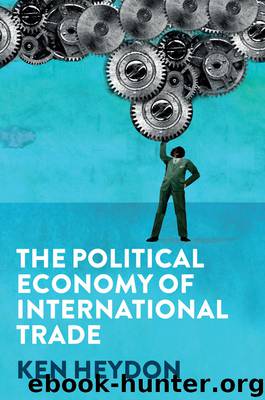The Political Economy of International Trade by Ken Heydon

Author:Ken Heydon
Language: eng
Format: epub
Publisher: Wiley
Published: 2019-10-30T16:00:00+00:00
Box 6.4 Rules of Origin in NAFTA (USMCA) and the European Union
The NAFTA (updated in 2018 to the United States–Mexico–Canada Agreement) contains some of the most complex ROO, occupying 140 pages of the agreement. NAFTA uses the full range of criteria for defining origin and some 70 per cent of products use multiple criteria. Change of tariff heading at HS 4 level is used for four per cent of all products. The more restrictive change of tariff heading at the 2-digit level is used in 42 per cent of cases. The HS 8 level is used for change of tariff rules in just six per cent of cases. Value content (of 50 or 60 percent) is used in 30 per cent of cases and technical requirements in 43 per cent of cases. There are also specific ROO for sensitive products such as textiles and clothing. Here NAFTA uses the infamous yarn forward rule, involving sequential changes of tariff headings from yarn to thread, thread to cloth and cloth to clothing, which in effect provides a captive market for US producers of textiles.10
The NAFTA approach as used by the United States provides for a seven per cent de minimis rule, and bilateral cumulation. Duty drawback is precluded, meaning that exporters are prevented from recouping tariffs paid for foreign materials that are subsequently used in products being exported to the partner country. Rules of origin are issued through self-certification by producers or exporters.
Despite the complexity and tightness of NAFTA rules of origin, US concerns related to the rising share of Asian value added in US imports under NAFTA prompted calls in 2018 to further strengthen NAFTA ROO. As a result – and as now embodied in the USMCA, NAFTA’s successor – the required share of a motorcar’s components made in North America rises from 62.5 per cent to 75 per cent. And up to 40 per cent of final assembly must be undertaken by workers earning an average of at least $16 an hour (seven times the average manufacturing wage in Mexico). This move, however, may well prompt foreign suppliers to cease investing within the USMCA region and simply export directly into the United States (unless MFN tariffs are raised to pre-empt this – see Chapter 5).
While harmonised across the various EU (and EFTA) agreements, the PanEuro system is still complex. In 60 percent of cases it uses CTH (HS 4 level change of tariff heading) but in 25 percent of cases there is also a value content criterion. Some 20 percent of products are subject to technical requirements. As in NAFTA, the restrictiveness of certain rules of origin criteria is mitigated by an either/or option. This means that exporters can choose between two different criteria to confer origin status.
The PanEuro framework provides for a 10 percent de minimis rule, but there are exclusions to this, in particular for textiles and clothing. Full cumulation applies to the EEA. Bilateral cumulation and diagonal cumulation are also applied. With diagonal cumulation, Morocco, for example, can count products originating in Algeria or Tunisia when origin rules are applied.
Download
This site does not store any files on its server. We only index and link to content provided by other sites. Please contact the content providers to delete copyright contents if any and email us, we'll remove relevant links or contents immediately.
The Secret History by Donna Tartt(16624)
The Social Justice Warrior Handbook by Lisa De Pasquale(11489)
Thirteen Reasons Why by Jay Asher(7788)
This Is How You Lose Her by Junot Diaz(5773)
Weapons of Math Destruction by Cathy O'Neil(5037)
Zero to One by Peter Thiel(4824)
The Myth of the Strong Leader by Archie Brown(4789)
Promise Me, Dad by Joe Biden(4447)
Beartown by Fredrik Backman(4419)
Stone's Rules by Roger Stone(4415)
How Democracies Die by Steven Levitsky & Daniel Ziblatt(4399)
The Fire Next Time by James Baldwin(4343)
100 Deadly Skills by Clint Emerson(4079)
A Higher Loyalty: Truth, Lies, and Leadership by James Comey(4033)
Rise and Kill First by Ronen Bergman(4012)
The David Icke Guide to the Global Conspiracy (and how to end it) by David Icke(3883)
The Farm by Tom Rob Smith(3872)
Secrecy World by Jake Bernstein(3782)
The Doomsday Machine by Daniel Ellsberg(3731)
